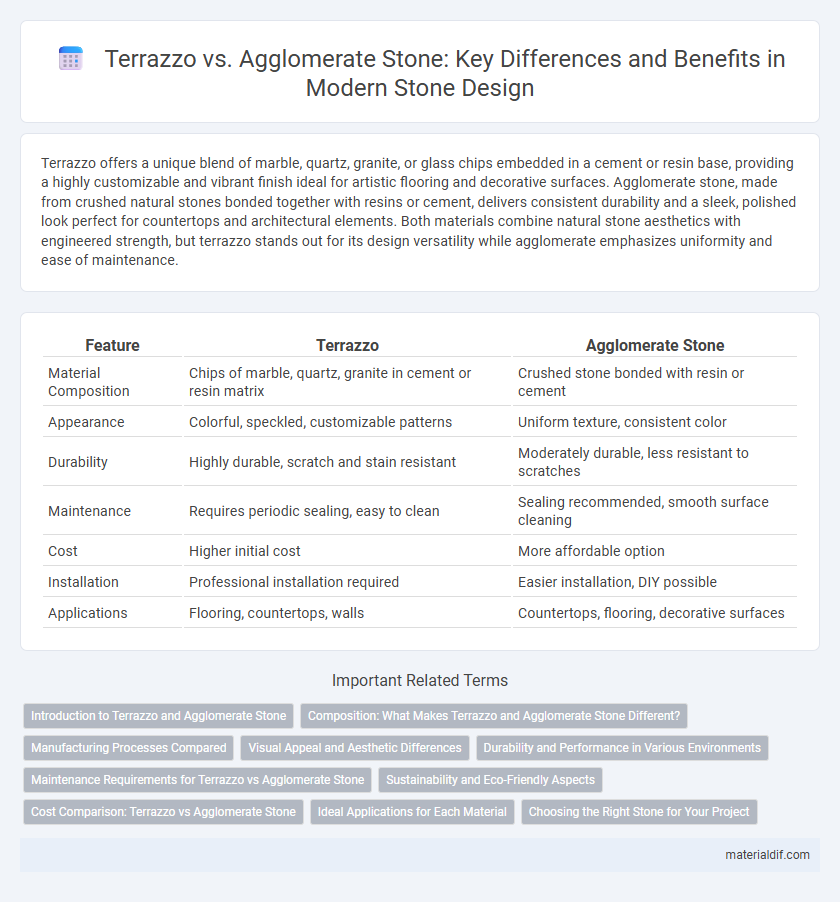Terrazzo offers a unique blend of marble, quartz, granite, or glass chips embedded in a cement or resin base, providing a highly customizable and vibrant finish ideal for artistic flooring and decorative surfaces. Agglomerate stone, made from crushed natural stones bonded together with resins or cement, delivers consistent durability and a sleek, polished look perfect for countertops and architectural elements. Both materials combine natural stone aesthetics with engineered strength, but terrazzo stands out for its design versatility while agglomerate emphasizes uniformity and ease of maintenance.
Table of Comparison
| Feature | Terrazzo | Agglomerate Stone |
|---|---|---|
| Material Composition | Chips of marble, quartz, granite in cement or resin matrix | Crushed stone bonded with resin or cement |
| Appearance | Colorful, speckled, customizable patterns | Uniform texture, consistent color |
| Durability | Highly durable, scratch and stain resistant | Moderately durable, less resistant to scratches |
| Maintenance | Requires periodic sealing, easy to clean | Sealing recommended, smooth surface cleaning |
| Cost | Higher initial cost | More affordable option |
| Installation | Professional installation required | Easier installation, DIY possible |
| Applications | Flooring, countertops, walls | Countertops, flooring, decorative surfaces |
Introduction to Terrazzo and Agglomerate Stone
Terrazzo is a composite material consisting of marble, quartz, granite, or glass chips embedded in a cement or epoxy resin binder, known for its durability and customizable patterns. Agglomerate stone is engineered by binding crushed natural stone fragments with resins or cement, offering a uniform appearance and enhanced strength compared to natural stone. Both materials are popular choices for flooring, countertops, and decorative surfaces, valued for their aesthetic versatility and resistance to wear.
Composition: What Makes Terrazzo and Agglomerate Stone Different?
Terrazzo consists of chips of marble, quartz, granite, or glass embedded in a cement or epoxy binder, creating a smooth, polished surface with diverse color patterns. Agglomerate stone combines crushed natural stones with resin or polymer binders, forming a dense, uniform material often engineered for durability and consistency. The key difference lies in terrazzo's traditional chip-in-binder aesthetic versus agglomerate stone's engineered composite composition.
Manufacturing Processes Compared
Terrazzo is made by embedding marble, quartz, granite, or glass chips in a cement or epoxy resin binder, followed by grinding and polishing to create a smooth surface. Agglomerate stone consists of natural stone fragments combined with polymer resins under high pressure and heat, resulting in a denser, more uniform material. The key manufacturing difference is that terrazzo is traditionally cast and cured in place or precast, while agglomerate stone is industrially produced using molding and curing techniques for consistent thickness and pattern.
Visual Appeal and Aesthetic Differences
Terrazzo boasts a vibrant, speckled visual appeal created by embedding marble, quartz, or glass chips in a cement or resin base, offering a customizable and artistic surface. Agglomerate stone features a more uniform appearance composed of crushed natural stone bound by resin, providing consistent color and texture with a polished finish. The choice between terrazzo's intricate patterns and agglomerate's sleek, consistent look influences interior design styles from eclectic modern to minimalist elegance.
Durability and Performance in Various Environments
Terrazzo offers exceptional durability with a composition of marble, quartz, and glass chips bound by cement or epoxy, making it resistant to cracking and suitable for high-traffic areas. Agglomerate stone, composed of crushed natural stones combined with resin, excels in impact resistance and maintains structural integrity in both indoor and outdoor environments. Both materials perform well under varying temperatures and moisture conditions, but terrazzo's seamless finish provides superior stain resistance, while agglomerate stone offers enhanced flexibility against thermal expansion.
Maintenance Requirements for Terrazzo vs Agglomerate Stone
Terrazzo requires periodic sealing and polishing to protect its surface and maintain its glossy appearance, while agglomerate stone demands regular cleaning with non-abrasive products to prevent staining and surface damage. Terrazzo exhibits higher durability against wear and is less prone to chipping, reducing long-term maintenance efforts compared to agglomerate stone, which may need more frequent repairs due to its composite nature. Proper maintenance of both materials enhances their longevity, but terrazzo's established sealing process offers superior resistance to moisture and stains.
Sustainability and Eco-Friendly Aspects
Terrazzo offers exceptional sustainability due to its use of recycled materials like glass, marble chips, and metal fragments bound by cement or resin, reducing waste and promoting eco-friendly construction. Agglomerate stone, composed mainly of crushed natural stone and resins, often lacks the extensive recycled content seen in terrazzo, making it less sustainable overall. Choosing terrazzo enhances environmental responsibility by minimizing extraction and supporting circular economy practices in building design.
Cost Comparison: Terrazzo vs Agglomerate Stone
Terrazzo typically costs between $40 and $90 per square foot, reflecting its labor-intensive installation and custom design options. Agglomerate stone, made from resin and natural stone fragments, generally ranges from $30 to $60 per square foot, offering a more budget-friendly alternative with quicker installation times. Choosing between terrazzo and agglomerate stone depends on project budget constraints and desired durability, as terrazzo often has a higher upfront cost but superior longevity.
Ideal Applications for Each Material
Terrazzo is ideal for high-traffic commercial spaces, such as airports and shopping malls, due to its durability and customizable design options. Agglomerate stone suits residential countertops and decorative wall cladding where aesthetic appeal and ease of maintenance are priorities. Both materials offer versatility but differ in structural composition and suitability based on specific environmental and functional demands.
Choosing the Right Stone for Your Project
Terrazzo offers a customizable blend of marble, quartz, granite, or glass chips embedded in cement or resin, providing durability and unique aesthetics ideal for high-traffic areas. Agglomerate stone, composed of crushed natural stone bound with resin, delivers consistent color and pattern, making it perfect for modern, uniform designs with enhanced stain resistance. Selecting between terrazzo and agglomerate stone depends on the desired look, maintenance requirements, and specific application needs of your project.
Terrazzo vs Agglomerate Stone Infographic

 materialdif.com
materialdif.com